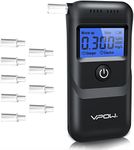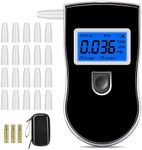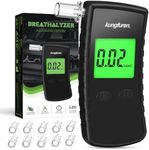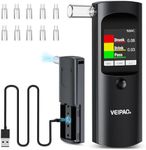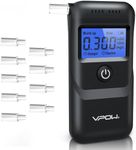Buying Guide for the Best Breathalyzer
Choosing the right breathalyzer can be crucial for ensuring safety and compliance with legal standards. A breathalyzer is a device that estimates blood alcohol content (BAC) from a breath sample. When selecting a breathalyzer, it's important to consider several key specifications to ensure you get a device that meets your needs. Understanding these specifications will help you make an informed decision and choose a breathalyzer that is accurate, reliable, and suitable for your intended use.AccuracyAccuracy refers to how close the breathalyzer's readings are to the actual BAC. This is important because an inaccurate reading could lead to dangerous situations or legal issues. Breathalyzers are typically rated for accuracy within a certain percentage of the actual BAC. High-end models used by law enforcement may have an accuracy of +/- 0.005% BAC, while consumer models might have an accuracy of +/- 0.01% BAC. If you need the breathalyzer for professional or legal purposes, opt for a model with higher accuracy. For personal use, a slightly less accurate model may suffice, but it should still provide reliable readings.
Sensor TypeThe sensor type in a breathalyzer determines how it measures BAC. The two main types are semiconductor sensors and fuel cell sensors. Semiconductor sensors are generally less expensive and suitable for occasional use, but they can be less accurate and more prone to false positives. Fuel cell sensors are more accurate and reliable, making them the preferred choice for law enforcement and frequent users. If you need a breathalyzer for regular use or professional purposes, a fuel cell sensor is recommended. For occasional personal use, a semiconductor sensor may be adequate.
CalibrationCalibration ensures that the breathalyzer provides accurate readings over time. Breathalyzers need to be recalibrated periodically, typically every 6 to 12 months, depending on the model and usage. Some models allow for user calibration, while others need to be sent back to the manufacturer. Regular calibration is crucial for maintaining accuracy. If you prefer convenience, look for a model that offers easy or user-friendly calibration options. For those who don't mind sending the device for professional calibration, this might not be a significant concern.
Display and ReadoutThe display and readout of a breathalyzer show the BAC results. A clear, easy-to-read display is important for quickly understanding the results. Some models feature digital displays with backlighting, which can be useful in low-light conditions. Others may offer additional information, such as warnings for high BAC levels. If you need to use the breathalyzer in various lighting conditions or require additional information, choose a model with a high-quality, backlit display. For basic use, a simple digital readout may be sufficient.
Response TimeResponse time is the duration it takes for the breathalyzer to provide a BAC reading after a breath sample is given. Faster response times are more convenient, especially if multiple tests are needed in a short period. Response times can range from a few seconds to over 30 seconds. If you need quick results, look for a breathalyzer with a response time of under 10 seconds. For occasional use, a slightly longer response time may not be a major issue.
MouthpiecesMouthpieces are the parts of the breathalyzer that you blow into to provide a breath sample. Some breathalyzers come with replaceable mouthpieces, which are important for hygiene, especially if the device is used by multiple people. The number of included mouthpieces and the availability of replacements can vary. If you plan to share the breathalyzer with others, ensure it comes with multiple mouthpieces and that replacements are easily available. For personal use, a few mouthpieces may be sufficient.
PortabilityPortability refers to how easy it is to carry the breathalyzer with you. Smaller, lightweight models are more convenient for carrying in a pocket or bag, making them ideal for personal use on the go. Larger models may offer more features but can be less convenient to transport. If you need a breathalyzer for use in various locations, choose a compact, portable model. For home or stationary use, portability may be less of a concern.





